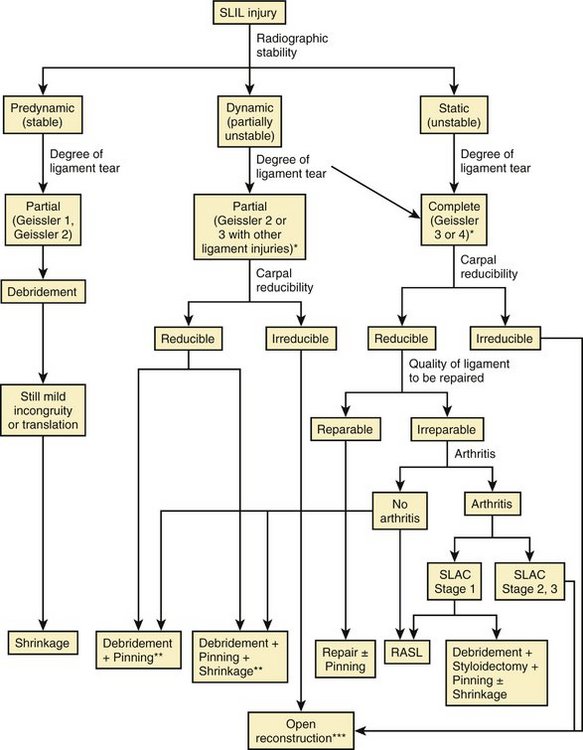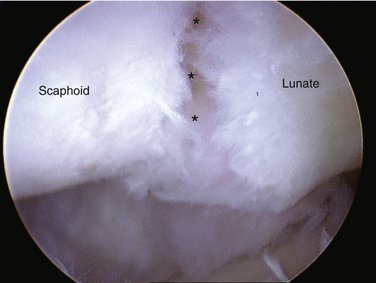CHAPTER 47 Arthroscopic Treatment of Scapholunate Ligament Tears
Scapholunate interosseous ligament (SLIL) injuries are common causes of mechanical wrist pain. Despite an increased knowledge of carpal injuries and improvements in radiological evaluation, the diagnosis of a SLIL tear can be difficult or missed unless the evaluating physician has a high index of suspicion and an appropriate level of understanding of wrist anatomy and injury patterns. Usually a detailed history and physical examination and a series of plain radiographs are sufficient to make a diagnosis of SLIL injury (Fig. 47-1). Occasionally, advanced imaging techniques, such as magnetic resonance imaging (MRI) with or without intra-articular contrast enhancement, can be helpful in establishing a diagnosis and evaluating the wrist for associated injuries.1–3 MRI usually detects large, complete tears better than partial, smaller tears, however, particularly if the tear configuration is oblique to the imaging plane, or the tear is smaller than the distance between contiguous image slices.
After successful introduction in the knee and shoulder, arthroscopy gained popularity as a useful modality to diagnose and treat a wide spectrum of wrist pathology.4,5 This procedure has become the gold standard for diagnosis of SLIL injuries.6–8 Arthroscopy is a minimally invasive procedure allowing direct observation of intrinsic and extrinsic carpal ligaments and articular cartilage integrity under static and dynamic conditions. Comprehensive and accurate diagnosis and treatment of all carpal injuries can be done concurrently.
Because a delayed or missed diagnosis of an SLIL tear can lead to progressive carpal instability and predispose the patient to a predictable pattern of carpal arthritis called scapholunate advanced collapse (SLAC),9–11 we believe that wrist arthroscopy should be considered early during the evaluation and management of a patient with a suspected SLIL injury. It should be used selectively, however, for patients with significant symptoms, for patients with a mechanism of injury consistent with SLIL injury, and for patients in whom conservative treatment has failed or in whom acute operative management is indicated.
Anatomy of the Scapholunate Complex
The wrist is a complex structure comprising multiple small joint articulations with stability resulting from a complex linkage of intrinsic, intercarpal ligaments and extrinsic capsular ligaments. The wrist can be thought of as two separate rows with hand motion being the composite effect of motion between the radius, ulna, proximal carpal row (scaphoid, lunate, and triquetrum) and distal carpal row (scaphoid, trapezium, trapezoid, capitate, and hamate). The scaphoid is uniquely situated in both rows on an oblique axis to stabilize the carpus, while still permitting coordinated relative motion between the two rows and the radius and ulna. The scaphoid is stabilized by many ligaments, including the SLIL, radioscaphocapitate, scaphotrapeziotrapezoid, scaphocapitate, and dorsal intercarpal.12
The SLIL is a C-shaped structure connecting the dorsal, proximal, and palmar surface between the scaphoid and the lunate, leaving the distal aspect of the joint bare of soft tissue allowing the evaluation of scapholunate articular congruity, preservation, and instability. This midcarpal visualization is essential in assessing the degree of instability between the two bones and in grading the spectrum of partial to complete injury.13 The dorsal and palmar portions of the SLIL are true ligamentous structures.14 The proximal portion is a membranous structure composed mainly of fibrocartilaginous tissue. In the absence of a tear, the transition between the dorsal and the proximal portion is not readily visualized during arthroscopy. Palpation of the SLIL with a probe permits differentiation, however, between the thick, taut dorsal ligament and the softer, thin proximal portion.
A partial SLIL tear may appear as a patulous, convex outpouching, rather than a confluent, barely discernible structure (Fig. 47-2). The probe may uncover a complete disruption of the insertion of the SLIL often from the lunate, which could not be perceived with observation alone. Partial tears may require palpation in the radiocarpal joint with a probe to appreciate the laxity and a thorough evaluation of the distal scapholunate joint articular surface congruity in the midcarpal joint to observe subtle incongruity or diastasis. A significant complete intrasubstance SLIL tear is readily visualized in the radiocarpal and the midcarpal joints.
Biomechanical and Kinematic Considerations
The three different portions of the SLIL have different biomechanical properties. The dorsal portion of the SLIL has a highest load at ultimate failure, followed by the palmar portion and then the proximal portion.15 Serial, sequential ligament sectioning studies in cadavers have shown that the SLIL is the primary ligament scapholunate stabilizer.16–21 No significant dissociation between the scaphoid and the lunate is shown, however, on static radiographs with an isolated, complete SLIL disruption.16,22 This is explained by the presence of secondary stabilizers of the scapholunate joint, which must be injured either acutely or chronically to show radiographic instability. Injury to the volar extrinsic (radiolunate and radioscaphocapitate),16,23 the distal intrinsic (scaphotrapezial),16,24 or the dorsal intercarpal ligaments and the SLIL is needed to visualize pathological carpal bone rotation radiographically.25
An isolated tear of the SLIL changes carpal loading and kinematics even without demonstrable radiographic abnormalities. Isolated loss of this major stabilizer of the carpus may lead to attenuation of the secondary supporting structures and progressive dissociation and rotation of the scaphoid and the lunate. With axial loading over time and without proximal restraint by the intact scapholunate joint, the capitate can descend proximally, further driving the scaphoid and lunate apart like a wedge. This results in midcarpal instability, loss of carpal height, and increased clinical symptoms as the bones increase their abnormal rotation. Changes in the radiocarpal, intercarpal, and midcarpal joint contact areas and loads in conjunction with the altered kinematics result in predictable SLAC arthritis. This process begins with radial styloid beaking and radial styloscaphoid joint narrowing (stage 1), then progresses proximally to alter the radioscaphoid facet proximal pole scaphoid articulation (stage 2), and finally progresses to the midcarpal capitolunate joint (stage 3).9
Treatment Options
Several factors need to be considered in clinical decision making about an arthroscopic procedure, not only to diagnose, but also to treat symptomatic scapholunate injuries (Fig. 47-3). Acute repairable lesions have heretofore been treated with open suture repair or reattachment with bone anchors. Previous reports have sought to separate acute injuries from chronic by using an arbitrary and unproven 6 weeks as a cutoff, with the implied understanding that only acute injuries could be repaired. Because the patient history is often unreliable regarding the first subtle injury versus the most recent and now symptomatic injury, however, dates alone should not indicate irreparable ligaments. We believe all such presumed SLIL injuries should be evaluated arthroscopically to stage properly and treat all injured structures. Repair, if possible, is preferred. Arthroscopy also has the added advantages that it is real time, can include direct palpation of structures, and can assess the dynamic nature of the instability and its reducibility (neither of which can be known from even the best MRI study).
Arthroscopic assessment guides and rationalizes the potential for repair by confirming the degree of injury and the severity of instability.13 Arthroscopic treatment options include the following either in isolation or in combination: ligament débridement, ligament thermal shrinkage, transarticular Kirschner wire (K-wire) fixation, and radial styloidectomy (see Fig. 47-3).
Complete repairable tears in the senior author’s (M.P.R.) experience are best managed with open techniques. If the dorsal ligament has been avulsed from its attachment, it can and should be primarily repaired either with transosseous suture or with suture anchor. Depending on the amount of associated soft tissue injuries, this can be augmented with any of the numerous variations on dorsal capsulodesis.26–28
Standard Arthroscopic Technique
After successful cannula placement, the trocar is removed, and a 30-degree angled, 2.7-mm arthroscope is inserted. Distention of the radiocarpal space is maintained by a pressurized irrigation system through the cannula with outflow through a separately placed 18-gauge needle into the radiocarpal joint in the 1,2 portal or the ulnocarpal joint through the 6R or 6U portals. The 3,4, 4,5, 6U, 6R, midcarpal radial, and midcarpal ulnar portals are necessary to complete a thorough diagnostic evaluation and allow therapeutic procedures.
Arthroscopic Débridement
Indications
Arthroscopic débridement alone is indicated for acute or chronic partial, but stable tears of the volar or membranous portion of the ligament in a patient with mechanical symptoms (Fig. 47-4). These patients usually have focal reproducible mechanical wrist pain over the dorsal scapholunate joint worsened by activity and normal x-rays. It is common to treat these patients conservatively for several months with splints and activity modification. Persistent symptoms often lead to MRI; imaging rarely provides a definitive diagnosis and does not illuminate the treatment options. Arthroscopy in these patients typically reveals a stable Geissler grade 1 or 2 injury pattern with slight midcarpal incongruity and joint widening. Patients’ symptoms are due to tears in the substance of the ligament, which, although not destabilizing, create mechanical impingement during wrist motion causing focal dorsal wrist pain and occasionally leading to a synovitis and dorsal capsular thickening. Débridement of these SLIL flap tears in either the dorsal or the membranous portions and partial synovectomy often ameliorate symptoms.











